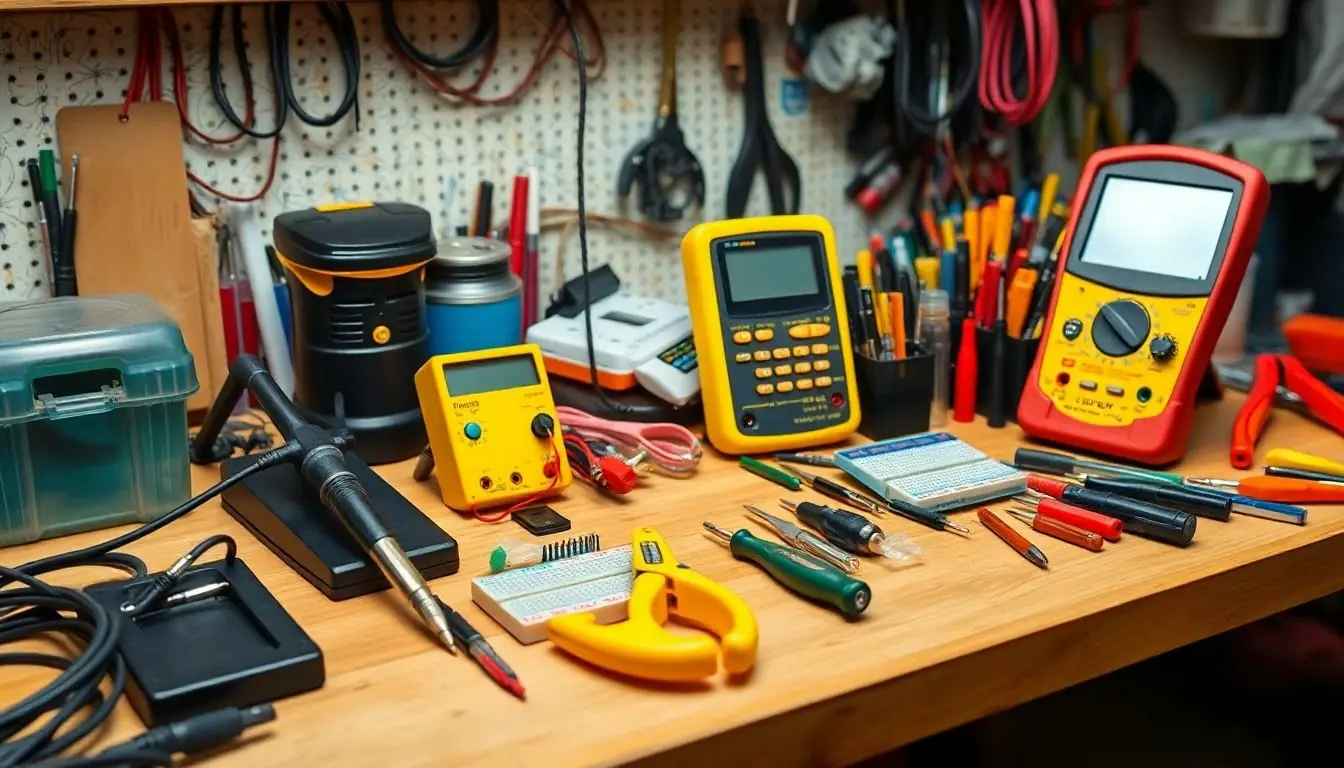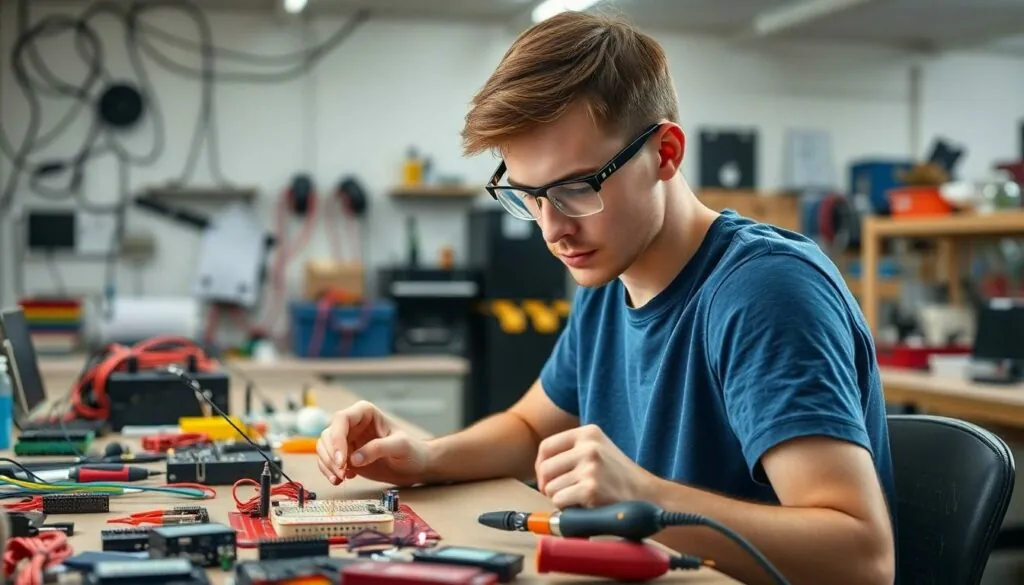In a world where gadgets reign supreme, why not take matters into your own hands? DIY electronics projects offer a thrilling escape from the mundane, transforming everyday materials into mind-blowing inventions. Imagine impressing friends with your homemade robot or a quirky LED display that’s more than just a pretty light show.
Table of Contents
ToggleOverview of DIY Electronics Projects
DIY electronics projects encompass a wide range of activities that allow individuals to create functional devices. Makers often use common materials like microcontrollers, sensors, and LEDs. Innovation takes center stage as enthusiasts turn ideas into tangible gadgets.
Countless projects exist for every skill level. Beginner projects might include building simple circuits or creating basic LED displays. Intermediate projects can involve programming microcontrollers for specific tasks. Advanced enthusiasts often tackle complex builds such as autonomous robots or home automation systems.
The benefits of engaging in DIY electronics are substantial. Skill development occurs in areas such as problem-solving, creativity, and technical knowledge. Many find satisfaction in building something unique from scratch. Success in a project can inspire further exploration into electronics and engineering.
Communities often exist online and locally for sharing ideas and troubleshooting. Discussion forums, social media groups, and maker spaces foster collaboration. Sharing projects and receiving feedback enhances the learning experience.
Tools and resources play a crucial role in DIY electronics. Soldering irons, multimeters, and breadboards are essential for effective building. Online tutorials and guides support individuals in their learning journeys. Many prefer using platforms like YouTube for visual aids, while others opt for dedicated websites with comprehensive instructions.
With ample resources available, the landscape of DIY electronics projects continues to expand. Exploring new technologies and materials opens up endless possibilities for enthusiasts. The thrill of creation drives individuals to expand their knowledge and refine their skills continually.
Essential Tools for DIY Electronics

Equipping a workspace with essential tools sets the foundation for successful DIY electronics projects. Certain tools become invaluable for hobbyists and advanced makers alike.
Basic Tools Every Hobbyist Needs
Soldering irons serve as a staple for assembling circuits. A multimeter measures voltage, current, and resistance, ensuring accuracy in projects. Wire strippers facilitate the preparation of wires for connections. Additionally, a breadboard allows for easy prototyping without permanent soldering. Pliers, such as needle-nose and diagonal-cutting types, assist in manipulating components securely. Finally, a toolkit with various screwdrivers tackles assembly across multiple device types.
Advanced Tools for Serious Projects
Oscilloscopes provide visual representation of electronic signals, critical for troubleshooting. Logic analyzers enable in-depth analysis of digital signals, enhancing understanding of circuit behavior. Reflow ovens make surface-mount soldering efficient, while 3D printers allow custom component creation. Hot-air rework stations facilitate soldering and desoldering of microchips. Access to PCB design software streamlines circuit board layout, ensuring precision. Enthusiasts find these advanced tools crucial for complex builds, pushing the limits of creativity and technology.
Popular DIY Electronics Projects
Makers often enjoy creating unique devices and gadgets through DIY electronics projects. Numerous options cater to different skill levels, allowing enthusiasts to find suitable challenges.
Beginner-Friendly Projects
Creating simple circuits provides a great introduction to DIY electronics. Projects like LED blinkers or basic alarms teach essential concepts quickly. Using microcontrollers, individuals can build interactive toys that respond to light or sound. Another engaging idea involves making a simple light-sensitive fan. This project utilizes light sensors to activate a small fan when it gets too warm. Beginners appreciate these projects because they foster learning about components and circuit design while offering a sense of accomplishment.
Intermediate and Advanced Projects
Intermediate projects expand on basic concepts. Individuals often explore building an Arduino-powered robot to navigate obstacles autonomously. This project integrates motors, sensors, and microcontrollers to teach programming and robotics. Another option includes designing an automated plant watering system using moisture sensors and water pumps. Advanced enthusiasts might tackle complex tasks like creating a home automation system that controls lights and appliances through a smartphone app. Such projects involve deeper knowledge of wiring, programming, and networking while pushing creative boundaries and problem-solving skills.
Benefits of DIY Electronics Projects
DIY electronics projects provide numerous advantages that enhance both personal and technical growth. Engaging in these projects fosters valuable skills in problem-solving and critical thinking.
Skill Development
Skill development ranks among the top benefits of DIY electronics projects. Makers gain hands-on experience with circuit design and component assembly, which bolsters their technical abilities. Learning to troubleshoot issues that arise during projects sharpens analytical skills and encourages perseverance. Exploring programming languages, often integral to many projects, builds a deeper understanding of software used in electronics. Completing a project, whether simple or complex, instills confidence and competence in tackling future challenges.
Creativity and Innovation
Creativity and innovation thrive in the realm of DIY electronics. Each project encourages individuals to think outside conventional boundaries, promoting unique solutions. Creating custom devices or repurposing everyday materials showcases inventive thinking and resourcefulness. When makers experiment with design and functionality, they often discover novel approaches to existing problems. These creative endeavors not only elevate individual projects but also contribute to collective knowledge within the community. Ultimately, embracing creativity leads to a greater exploration of technology and artistic expression.
Challenges in DIY Electronics
DIY electronics projects present various challenges that can test a maker’s skills. Understanding these obstacles can enhance the project experience.
Common Mistakes to Avoid
Makers frequently overlook circuit connections, leading to erratic performances. Not verifying component specifications can cause compatibility issues. Ignoring safety protocols, such as using protective equipment, poses risks during soldering or testing. Errors in programming, especially syntax mistakes, hinder project functionality. Failing to document changes can complicate troubleshooting later. Skipping thorough testing before finalizing a build often results in unforeseen failures.
Troubleshooting Tips
Begin troubleshooting by isolating the issue within the circuit. Use a multimeter to check voltages and continuity, ensuring components function as intended. Verify that all connections are secure and components are placed correctly. Consult online forums for insights from experienced makers who faced similar challenges. Take note of error messages in programming, which often highlight specific problems. Revisit documentation to understand project structure and identify discrepancies. Testing components individually can clarify which part malfunctions.
DIY electronics projects offer an exciting avenue for creativity and innovation. Whether it’s building a simple LED circuit or a complex robotic system, there’s something for everyone. Engaging in these projects not only boosts technical skills but also fosters a sense of accomplishment that comes from creating something unique.
With a supportive community and a wealth of resources available, enthusiasts can easily navigate challenges and enhance their learning experience. The thrill of discovery and the joy of problem-solving make DIY electronics a fulfilling pursuit. As makers continue to explore new technologies and refine their skills, the possibilities are endless.




